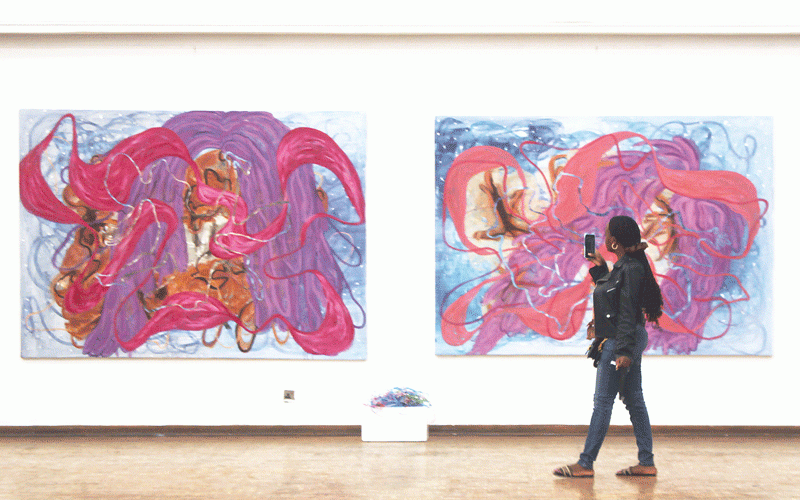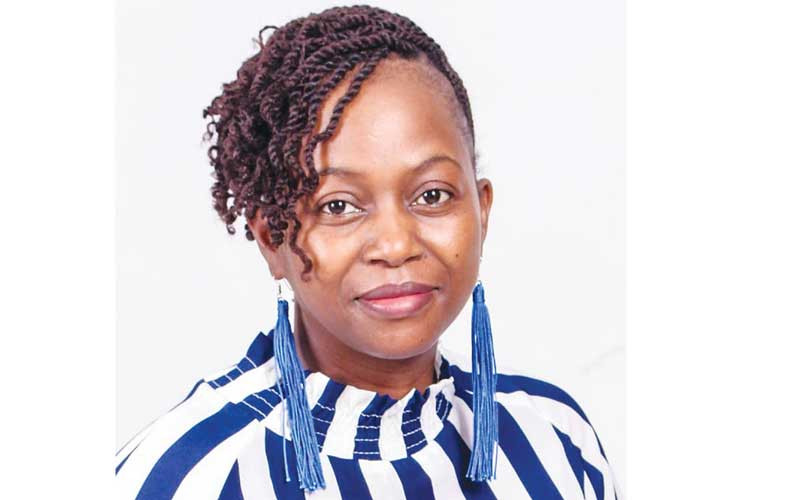
WALKING through Amanda Shingirai Mushate’s Ingoma Kamama Wami?, her first solo exhibition at the National Gallery of Zimbabwe (NGZ) brings up both familiar and new impressions.
Those acquainted with her work will quickly register the hypnotic meandering lines that are almost her signature style, and the noticeable presence of the colour blue.
Some might suspect that she has begun to repeat herself. Doubt gives way to wonder as subtle shifts lead to new revelations on her developing craft and evolving themes.
Curated by supercharged and ever-busy Fadzai Muchemwa (curator for Contemporary Art at NGZ), Ingoma Kamama Wami? showcases Mushate confronting and resolving her experiences through art.
It is an undertaking that she has always done, which makes her work more authentic and less preoccupied with external validation.
“With this show I chose to look at my mom’s life and try to understand what I’m going through as a parent, a married person and an artist,” she said.
Mushate’s mother, who is probably the artist’s greatest fan and supporter, has been a constant reassuring and visible presence in her daughter’s career.
- Exhibition celebrates love and art
- At ease with Badza, a man of many jackets
- A great showing for Zim at FNB Art Joburg
- Mushate resolves life experiences through art
Keep Reading
The matriarch single-handedly raised Mushate and her older brother after their father reportedly left when the artist was only two years old. Part of the story is narrated by the artist's mother in a video installation where she is seen performatively braiding the artist’s hair. “To this day, I am most grateful for one thing: I was able to keep my children in school during those incredibly hard times.” she said without any trace of resentment.
In 2024 Mushate had a joint exhibition at First Floor Gallery (FFG) with spouse Tashinga Majiri which was titled Rudo Rwunouya Nemabasa (Love comes with work).
The project put emphasis on how sustaining a marriage and other close relationships requires deliberate input and actions. Earlier in 2022 her solo exhibition at FFG Victoria Falls was titled Shuviro Yamai. Coming after she had become a mother, the body of work reflected some fierce energy perhaps ignited by the kicking-in of maternal instincts for nurturing and protection.
The work bore evidence of hard work through a dynamic range of vibrant colours and dense abstraction. Back in 2021 she formally introduced herself with confidence in Nguva ine Muridzi, establishing her signature style of light and shadows, overlaid with infinitely looping lines, some playful figuration like a Keith Haring drawing and what can with hindsight to be regarded as a portentous depth. The title of the exhibition was a tacit declaration that patience and hard work bore fruit after a long period of preparation and anticipation.
The trajectory of Mushate’s career seems to indicate that her life has been a journey through phases and seasons of womanhood.
As if pointing to a collective neurosis she comments, "We experience the same things in different ways.’’ The artist handles her emotional crisis during the period of transition by channelling it through her work in a way that allows for internal cohesion. Other women in her position might be knocked off balance, invoke projections and choose alienation as a means of self-preservation. Mushate turns the existential crisis into fodder for her creative impulse. The artist’s evolving practice documents her spiritual journey.
In her latest work one may sense Mushate eagerness to move on, a sense of frustration with a medium that used to give.
When one thinks of the self-exciting American abstract painter Mark Rothko and another American abstract painter Jackson Pollock’s alcoholism and depression, perhaps abstraction is not exhaustive as a means of self-expression and emotional outlet.
Mushate finds a way to break the surface and come up for air. The artist’s meandering lines thicken and are bloated at some points but are never broken on their infinite circle. Some bold splashes of colour prevent monotony and boredom. Behind the lines some figuration begins to emerge, like the unsettling underwater visions of the protagonist in Canadian feminist writer Margaret Artwood’s novel Surfacing.
The figures generate a pulse like the heartbeat of a foetus. It is a disturbing invasion by entities untethered to the ecosystem. A teddy bear floats, some figures stand upright, while others are entangled in a horizontal position as if they were wrestling with life or death. The new work pushes the boundary of the artist’s self-expression and tests the assumptions of those who were used to the idyllic scenes of her previous work.
Zvidzidzo sublimates the abstraction to reveal the profile of a woman’s body that could be a mirror of Sarah Baartman. Zvishuwo zvemoyo reveals a family represented by the figures of a woman, a man and a child. The diptych, Chimiro nehukoshwa, continues to explore the possibilities of the abstract form by allowing the lines to collide, merge and coalesce into new forms. But before the figures emerging from the shadows in Mushate’s abstract paintings become fully manifest, the artist has, in the typical gestative capacity of a woman, given birth to something new in the form of sculptures made out of synthetic fibres. With the introduction of the colour-saturated sculptures, perhaps the advancing shadows will recede and her incarnated brush strokes take the artist on a new, exciting journey.
Mushate's practice is a vulnerable emotional tightrope walk, which, like her smile, teeters on the edge of breaking into peals of laughter or tears. "I believe it is essential to look within yourself and understand yourself more,” she said. Her honesty reflects other people’s fragility better than their closet mirrors.







